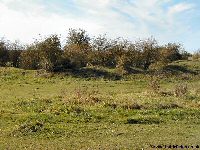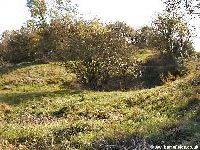Ovillers & la Boiselle
The World War One Battlefields site is undergoing a major update, with pages being converted to a new, user-friendly mobile format. The updated pages can be found at Updated World War One Battlefields. Some pages such as this one remain in the original format pending update.
These two villages are located either side of the main Albert-Bapaume road (today the D929). Ovillers (which is properly known as Ovillers la Boiselle) lies to the north of the road, and la Boiselle to the south.
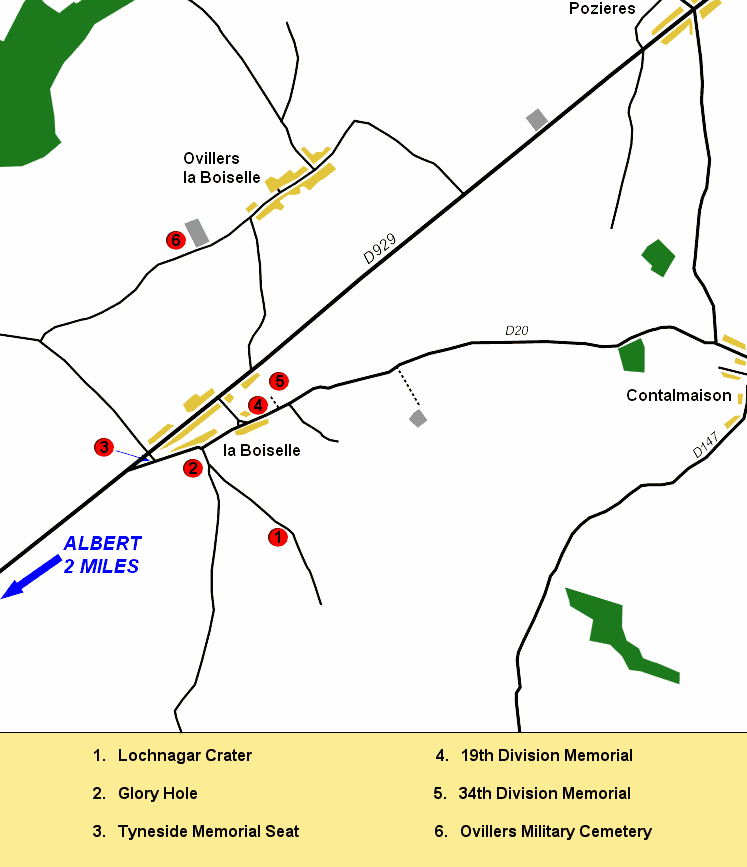
Map of Ovillers & la Boiselle area
On the 1st of July 1916, both villages were just behind the German front lines. This is today marked by a sign on the D929 road. The gap between the German and British front line trenches was wide in front of Ovillers (to the left of the road as you head towards Bapaume), and very narrow just to the right of the road near la Boiselle.
The area also had geographical features that had importance during the Somme battles. The road is higher than the ground to the left (north) of it, and that valley was called Mash Valley. To the right (or south) of la Boiselle is another valley called Sausage valley. The latter may have been named after a German observation balloon (or 'sauasage') which flew there, although there are also suggestions that the appearance of the contour lines on the map led to the name. After Sausage Valley was named, it was perhaps inevitable that the valley to its north would be named 'Mash'!
The attacks here on the 1st of July were made by the 34th Division, with the 8th Division to their north in front of Ovillers. They met with little success, and casualty rates in the attacking battalions were extremely high. A number of mines were blown on the first day of the Somme, and two large mines were blown here two minutes before the infantry attacked; Lochnagar and Y Sap. The crater made at Y Sap (which was located just to the north of the main D929 road) has since been filled in, and no trace remains. Lochnagar crater, however, remains as one of the best known sites in the 1916 Somme battlefield region.
Lochnagar crater
The Lochnagar mine crater is one of several which remain visible on the Western Front today. In the Somme area, others may be seen at Hawthorn Ridge near Beaumont Hamel and on the edge of High Wood. Others can be seen in Flanders, particularly around Messines.
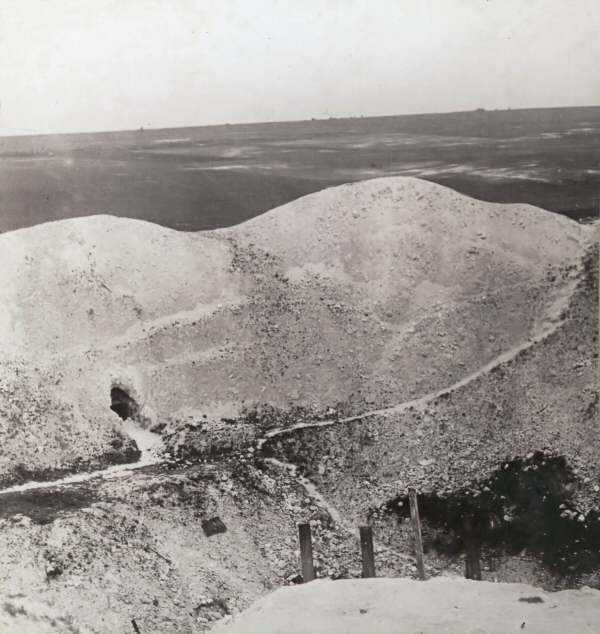
Mine crater at la Boiselle. Photo: Realistic Travels
Lochnagar crater is well signposted (as 'la Grande Mine'), to the right from the main road if you are travelling from Albert in the direction of Bapaume. There is parking near the crater although this is a popular stop on school tours, and so coaches often come up and down the narrow roads and turn before or after parking.
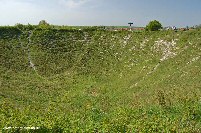
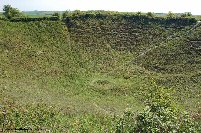
Two views of the Lochnagar crater today
Lochnagar crater is now owned by Richard Dunning. In Before Endeavours Fade is a pair of photographs showing how much the farming on the land around had encroached towards the crater over the years. Hence, in 1978, Mr Dunning purchased the land to ensure it could be maintained suitably as a memorial, as the bodies of many German soldiers who would have been killed when it went off probably still lie here. It is less likely that there are many British soldiers who lie within the crater still, although in October 1998 the remains of a soldier were found in the land just behind the crater. A cross now marks this spot, and the soldier was identified as Private George Nugent, of the 22/Northumberland Fusiliers (3rd Tyneside Scottish). He was later reburied in Ovillers Military Cemetery (see below on this page).
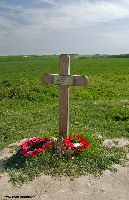
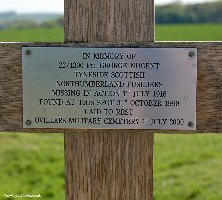
The cross marking the spot where the remains of Pte George Nugent were found in 1998
It is possible to walk all around the edge of the crater, but access to the crater itself is not permitted. It was created by the explosion of two charges of ammonal (36,000 lbs and 24,000 lbs 60 feet apart) under a German position called Schwaben Hohe, and the crater originally measured some 300 feet across and 90 feet deep. Unfortunately, the attack in this sector on the 1st of July was not successful, despite the mine, and the losses sustained particularly by the Tyneside Scottish and other units of the 34th Division were heavy. The action here is particularly well described in Martin Middlebrook's The First Day on the Somme.
There is a large wooden cross made from Tyneside timber that stands beside the crater, and this is one of a number of memorials of various kinds that exist around the crater. There are often many wreaths laid at the foot of this cross, laid by visitors to this site.
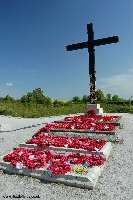
The Cross of Tyneside wood at the Lochnagar crater
Other memorials include the Grimsby memorial seat (shown below) and also two other benches; the Harry Fellows bench in memory of those who fell on the Somme and a third dedicated by the Friends of Lochnagar.
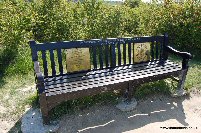
The 'Grimsby Chums' seat at the Lochnagar crater
Around the edges of the crater, the land still shows the vestiges of shell holes and is uneven and cratered. The hard bare chalky path round the edge of crater can be slippery if wet. From the edge of the crater the height of this key point allows an appreciation of the surrounding battlefields.
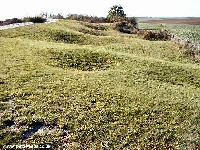
Remains of shellholes ground around the Lochnagar crater
Below is a picture of one of the craters at la Boiselle taken just after the war ended. It is not clear whether this is Y Sap or Lochnagar, but the grisly reminders of war are clear to see.
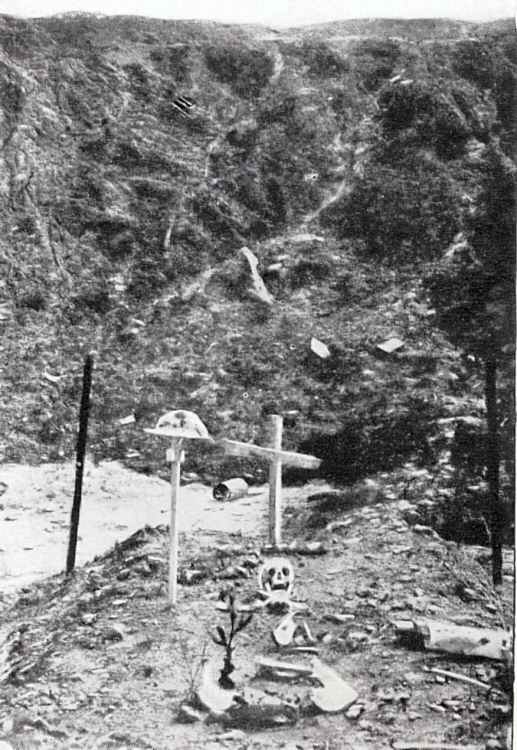
Mine crater at la Boiselle just after the War. Photo from Michelin Guide to the Somme Battlefields
la Boiselle
An area just to the south of the main D929 road was known as the Glory hole. Here, the front lines were extremely close together, and small mines had been blown by both sides to try and gain some advantage. However, on the 1st of July there was no infantry attack from this short stretch of line. Although private, part of this area can be seen from the roads to it's immediate north and east. The land is cratered and uneven, and though trees and bushes make it hard to see much, it is actually quite a large area. The right hand photo below shows a particularly deep crater which can be seen from the Contalmaison road.
Recently it seemed likely that this site might be under threat from developers. However, it now (March 2006) seems unlikely that building will take place on the Glory Hole, which is good news for those with an interest in the Great War.
Just off the D929 on the right (towards the Lochnagar crater) is the la Boiselle Tyneside memorial seat. This location is just to the north-west of the 'Glory Hole' and also almost exactly on the British front line of July 1st, 1916. This memorial was erected quite soon after the War, as inscriptions on its rear show. These state that it was approved by Presidential decree on the 13th October 1921, erected by the trustees of the Colonel Joseph Cowan Fund and opened by Marshal Foch on the 20th April 1922.
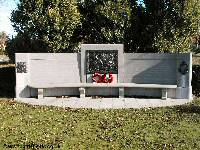
The Tyneside Memorial seat at la Boiselle
On the front, the central plaque depicts a classical mounted warrior battling a dragon, whilst a weeping maiden looks on.
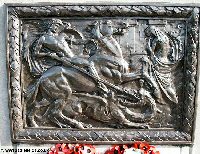
The central brass panel of the Tyneside Memorial seat
The inscription, in English on the left and French on the right reads:-
"Greater love hath no man than this that he lay down his life for his friend. In front of this monument on 1/7/16 the 'Tyneside Scottish' and the 'Tyneside Irish' brigades attacked the enemy. For many hours the fortunes of arms fluctuated but ere night had fallen the two Tyneside Brigades with the aid of other units of the 34th Division attained their objective. Think not that the struggle and the sacrifice were in vain."
The motifs of the two Brigades, officially the 102nd and 103rd Brigades, are displayed on the pillars flanking either side of the seat.
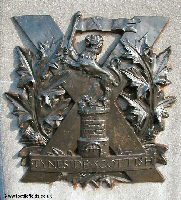
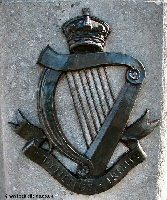
The brass insignia of the Tyneside Scottish (left) and Irish
In front of la Boiselle church, which is on the left side of the D20 leading to Contalmaison, stands the memorial to the 19th (Western) Division. This is in the form of a stone cross, with a butterfly on the top (which was the emblem of the Division). The 19th Division attacked la Boiselle in the early morning on the 2nd of July 1916, and managed to gain most of the village, although the Germans still held a line that ran through the church.
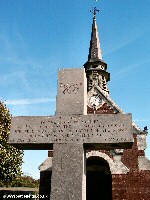
The 19th Division Memorial at la Boiselle
The inscription at the top shows that the memorial commemorates not only the attack on the 2nd July 1916, but also the 19th Division throughout the remainder of the Somme battles that year, up until November the 20th. As well as la Boiselle, the names Bazentin-le-Petit (where the Division fought on 23rd of July) and Grandcourt (where the Division withdrew on the 19th November, right at the end of the Somme campaign) are listed.
On the base of cross are the units which made up the 19th Division; on the front Artillery, Engineers, Pioneers, RAMC and RASC, and on the other three sides the battalions of the three infantry brigades, the 56th, 57th & 58th.
Further up the D20 past the church, there is an octagonal brick structure with green metal doors on the left. A sign on its front reads 'Rue Georges Cuvillier'. A grass track just before and to the left of this leads to the 34th Division memorial. This is in the form of the figure of Victory, on a stone plinth, originally holding up a laurel wreath (see contemporary picture below). This memorial was unveiled on May the 23rd, 1923, by Major-General Sir Cecil Nicholson, who had commanded the Division from 25th July 1916 until the end of the war (he had taken over after Major-General Ingouville-Williams was killed). After this, school-children laid flowers at the base.
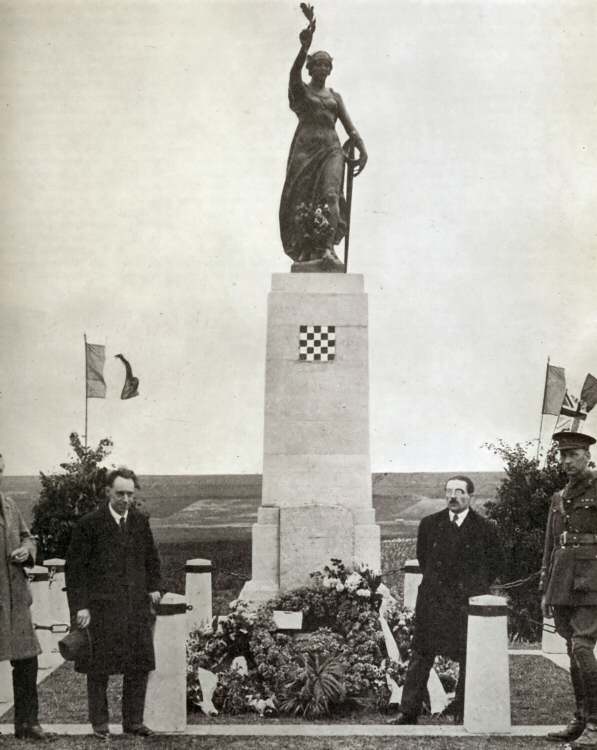
The 34th Division Memorial complete with laurel wreath. Photo: Central Press
The memorial is said to be located where the Divisional HQ stood in 1916. Towards the top of the plinth is the checkerboard insignia of the Division, now rather faded. The bronze figure of Victory no longer holds the laurel wreath. The views ahead and across towards Ovillers Military Cemetery and the Thiepval memorial in the background to the right are impressive. The Division's units are listed on the side panels; infantry on the left and artillery and engineers on the right.
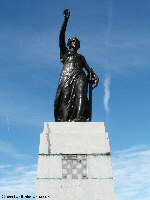
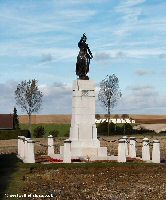
The 34th Division Memorial today
The inscription commemorates the 34th Division (which included the Tyneside Scottish & Irish Brigades referred to earlier, see the Tyneside Memorial Seat). The memorial records that the Division was engaged for the first time in battle near this spot on the 1st of July 1916. All 12 infantry battalions of the Division were to be involved, in successive waves. In around 10 minutes nearly 80% of the men in the leading battalions had become casualties; mainly caused by German machine-guns. These, once the British barrage lifted, were able to sweep across No Man's Land (often wide here) and catch the advancing soldiers in the open.
There was some success on the extreme right of the 34th Division frontage on the 1st of July, but in front of Ovillers and la Boiselle, the only gains came in between Lochnagar and la Boiselle, where the 21st, 22nd and 26th Northumberland Fusiliers (the first two battalions from 102 Brigade, the last from 103 Brigade) started to advance the moment the mine at Lochnagar was blown. Note that George Nugent (see both Lochnagar Crater above and Ovillers Military Cemetery below) whose remains were found by Lochnagar crater was in the 22/Northumberland Fusiliers (or 3rd Tyneside Scottish). The troops took German trenches to the north and north-east of Lochnagar crater, around Scwaben Hohe and on the norther slopes of Sausage Valley.
However, there were no reinforcements for the Divisional Commander, Major-General Ingouville-Williams, to deploy, and so the 19th Division were detailed to carry out an attack on la Boiselle after dark. They successfully took the village early the next day (see above).
Ovillers
Ovillers is the village to the north of the D929. From the main road, there is a good view of the large Ovillers Military Cemetery. This contains the burials of nearly 3,500 soldiers, only 31% of which are identified burials.
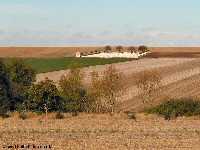
Ovillers Military Cemetery from the D929 road
The cemetery is located in what was No Mans Land, and from the front of the cemetery, where a bank slopes down to the road, there are clear views of the Albert basilica to the right, of Mash valley in front, and the main road running on the spur ahead. Charles Edmonds, returning across this area on July the 16th described it in A Subaltern's War.
"A little grass had still room to grow between the shellholes. The village was guarded by tangle after tangle of rusty barbed wire in irregular lines. Among the wire lay rows of khaki figures, as they had fallen to the machine-guns on the crest, thick as the sleepers in the Green Park on summer Sunday evening........the flies were buzzing obscenely over the damp earth; morbid scarlet poppies grew scantily along the white chalk mounds; the air was tainted with rank explosives and the sickly stench of corruption".
The cemetery was originally only Plot 1, located a little back from the front right of the cemetery. This was started around August 1916, and used until March 1917. It was then quite small, less than 150 graves, but the cemetery was increased significantly after the Armistice. This was mainly as a result of bringing in bodies from the local battlefields of Ovillers, La Boisselle, Pozieres and Contalmaison. This explains the high number of unidentified burials located here.
One notable grave in Ovillers Military Cemetery is that of Private George Nugent of the Tyneside Scottish, who was reburied here on the 1st of July 2000 after his remains were found at the Lochnagar Crater in 1998 (see above).
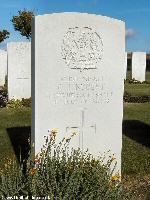
Grave of Pte George Nugent, whose remains were found at Lochnagar in 1998
Special memorials to 35 soldiers who were originally buried in Mash Valley Cemetery but whose graves are lost are located at the front right of the cemetery.
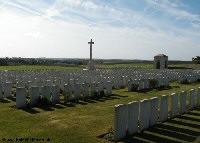
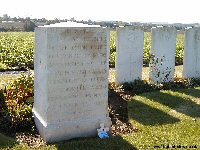
Ovillers Military Cemetery and the Special Memorial to soldiers originally buried at Mash Vallery Cemetery
There are also special memorials to 24 casualties who are believed to be among the unidentified buried here. One records a casualty who is known to be buried here - Major John Walsh of the 22nd Battalion Royal Fusiliers, who died of wounds aged 34 on the 19th of February, 1917.
Sources & Acknowledgements
Commonwealths Wargraves Commission website
Rose Coombes: Before Endeavours Fade
Charles Edmonds: A Subaltern's War
Brig-General Sir James Edmonds: Military Operations France & Belgium 1916 (Volume 1)
Major & Mrs. Holt: Battlefield Guide to the Somme
Chris McCarthy: The Somme - the day by day account
Martin & Mary Middlebrook: Somme Battlefields
Martin Middlebrook: The First Day on the Somme
Paul Reed: Walking the Somme
Gary Sheffield & John Bourne: Douglas Haig War Diaries and Letters 1914-1918


